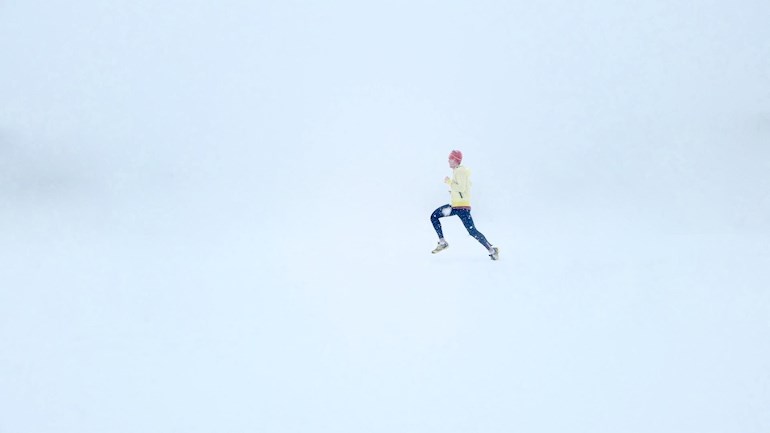Photo by Isaac Wendland on Unsplash
We have runners from all around the world on this forum, so one runner’s hot weather is another’s cold…….and vice versa. Therefore cold is a relative matter, but if you are beginning to feel the cooler air, the following may help you prepare.
Whatever you wear in hot weather…...for me it is as little as I can decently get away with….it may not suffice as temperatures drop. My summer kit is a singlet and shorts. As it cools a tee shirt replaces the singlet and then a long sleeve tee shirt. That will be perfectly adequate for me for about nine months of the year, with long running trousers being worn the rest of the time.
Dressing for five degrees Celsius above the outdoor temperature is often stated as a guide for runners and over the years I have learned what I will likely need to wear according to the weather forecast, or sticking my head out of the door. Layers are definitely the way to go. You will only find out what works for you by experimentation. Note the actual temperature for future reference.
I have rarely run in temperatures much below freezing and can only remember one run when I was uncomfortably cold and that was because I forgot my gloves……...an essential in my book. I use running gloves which have conductive finger tips, making the use of touch screens possible.
My full winter clothing set up consists of a base layer of short sleeved compression top and compression shorts, long sleeved tee shirt, full length running trousers (similar to Ron Hills), gloves and at least one buff (one for head and one for neck). In the most extreme conditions (very rarely) I have been known to wear a light weight windproof jacket and a beanie hat. My wife always wears at least one more layer than me and is happy to strip off the top layers as she goes. I hate running with anything hanging around my waist, so tend to wear less. You may find it cool as you set off, but will always warm up.
The only times I will do a dynamic warm up before leaving the house are when the temperatures are heading down. This gets the circulation going and warms up muscles before you hit the cold air, which can have a contracting effect on muscles meaning it takes longer to warm up. My prerun pint of very dilute apple juice is also made with warm water, to prevent any cooling of my core.
With colder weather we usually have shorter days, meaning that running in the dark becomes inevitable for the committed runner. You need to be able to be seen clearly, even on pavements, so hi viz is recommended and is essential if running on roads. Body lights or headtorches are also useful and if you are either on the road or going off road, a must have. Many have front and back lights to ensure you can be seen all round. I have only ever used head torches and these have the advantage of illuminating where your head is pointing, whereas body lights only shine in front of you. My first head torch was embarrassingly powerful, enabling me to see across fields and alarm distant sheep. It also sat forward on my head, so tended to wobble annoyingly. Close fitting headtorches are preferable. You can also get illuminated running shoes, but I would not have wanted to negotiate my muddy cross country routes wearing those.
We all get used to running in, and enjoying, rain, but winter rain, snow and ice can be different beasts. Getting soaking wet in cold winds can not only be unpleasant, it can reduce your body temperature rapidly possibly leading to hypothermia, so look at forecasts and the sky and take a waterproof if it might be needed. Wind chill needs to be factored in. If you are only out for a short run, it might not matter, but best to be prepared. Snow is usually fine and a great experience, especially if you have well studded trail shoes, but ice requires planning. Both snow and ice can reduce the amount of ground you will cover in a given time, so plan your routes accordingly. Icy pavements and roads are not a good running surface, but if you can get onto grass, generally you will have plenty of grip, but do be cautious. Black ice, where rain has frozen onto very cold ground is best avoided.
Cold air can constrict the airways, making breathing difficult and sometimes painful. This can often be overcome by wearing a buff or facemask over your mouth and nose, which helps to prewarm the air.
Winter running can provide some memorable and beautiful experiences and becoming familiar with your running routes through all the seasons is part of the joy of being a runner. Being prepared is the key thing. Protect extremities (head and hands), warm up, layer up and make sure you can see and be seen………...then the winter wonderland is yours for the taking.
Keep running, keep smiling.
There are more FAQ posts giving general information here healthunlocked.com/couchto5...

